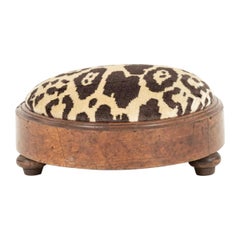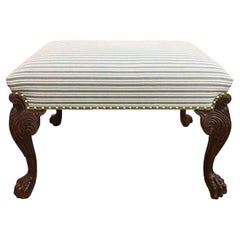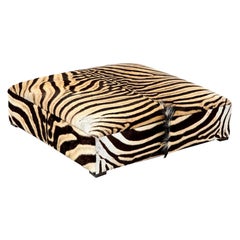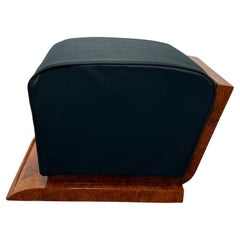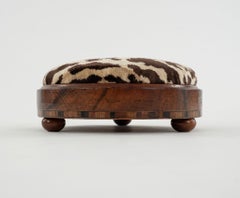Veneer Footstools
4
to
3
1
4
4
4
1
1
3
1
1
1
Height
to
Width
to
Depth
to
4
4
3
2
2
1
2
1
1
Technique: Veneer
19th Century American Empire Round Upholstered Footstool.
Located in Vero Beach, FL
19th Century American Empire Round Upholstered Footstool.
Round, footed stool with rich mahogany wood veneer stands on four short, hand-carved, flared and graduated legs. A great room accessory...
Category
19th Century Antique Veneer Footstools
Materials
Upholstery, Mahogany
Cubic Art Deco Stool, Walnut Veneer, France, circa 1930
Located in Regensburg, DE
Beautiful original Art Deco stool from France about 1930.
Walnut veneered and polished. Covered with anthracite fabric and border finishing.
Dimensions: H 38 cm x W 36 cm x D 37 cm.
Category
1930s French Art Deco Vintage Veneer Footstools
Materials
Fabric, Walnut
Empire Ottoman/Italian Zebra Upholstery
Located in Malibu, CA
Flame mahogany curvy 19thC English Empire period ottoman in Italian Zebra Upholstery on the original casters.
Category
Mid-19th Century Italian Empire Antique Veneer Footstools
Materials
Mahogany
19th Century Nobilis Velours Leopard Footstool
Located in Houston, TX
19th Century French walnut footstool newly upholstered in Nobilis Leopard Velours fabric.
Category
19th Century Antique Veneer Footstools
Materials
Walnut, Velvet, Hardwood
Related Items
Lion Feet Ottoman
Located in Sag Harbor, NY
Lion feet ottoman upholstered in Antique textile from Katie’s personal collection. Complete with 4200 and green tape trim.
22″d x 32″w cushion, 37″ d x 27″ w including legs.
19″ ov...
Category
19th Century Antique Veneer Footstools
Materials
Fabric, Wood
Zebra Ottoman / Coffee Table, Large Square, Two Zebra hides, Custom Made In USA
By Area ID
Located in New York, NY
Large zebra ottoman, measures: 42 inches by 42 inches and 14 inches high. Great as a coffee table or ottoman. Built in our NJ factory.
Made of beautiful zebra hides from South Africa...
Category
21st Century and Contemporary South African Campaign Veneer Footstools
Materials
Zebra Hide
H 14 in W 42 in D 42 in
Mid century Zebra Hide & Chrome Ottoman
Located in West Palm Beach, FL
Vintage, C.1970s large Zebra hide Ottoman on a straight line square Chrome base..
There a a few repairs that are hand stitched, to the hide, very well done..
The Chrome base is in ve...
Category
1960s American Mid-Century Modern Vintage Veneer Footstools
Materials
Zebra Hide
Zebra Hide Ottoman, Chocolate & Cream, Round, Contemporary, New Hides, USA Made
By Area ID
Located in New York, NY
Decorative zebra hide ottoman. Zebra hides are from South Africa and the ottoman is made in NJ. Measures: diameter is 36 inches and height is 12 inches. The mane of the zebra is very...
Category
21st Century and Contemporary South African Campaign Veneer Footstools
Materials
Zebra Hide
Art Deco Tabouret by UP Zavody, 1930s
Located in Praha, CZ
Designed by Jindrich Halabala for UP Zavody. Made in Czechoslovakia
Made of wood, fabric. Very good original condition.
Category
1930s Czech Art Deco Vintage Veneer Footstools
Materials
Fabric, Wood
Art Deco Stool, Material Iron and Brown Leather Country France, 1930
Located in Ciudad Autónoma Buenos Aires, C
Stools Art Deco.
Material: iron and leather
You want to live in the golden years, this is the stool that your project needs.
We have specialized in the sale of Art Deco and Art Nou...
Category
1930s French Art Deco Vintage Veneer Footstools
Materials
Iron
H 17.72 in W 21.66 in D 18.12 in
Huge “Soho Buttoned-Drum” Ottoman Footstool in Dark Grey Italian Velvet
By George Smith
Located in Barrowford, GB
This is the most spectacular, unused Bespoke “Soho Buttoned-Drum” Ottoman/Footstool, dressed in a breathtaking, peerless, top-grade, Italian-Velvet Fabric...
Category
2010s Veneer Footstools
Materials
Velvet
Art Deco Stool, Material Iron, Country France, 1930
Located in Ciudad Autónoma Buenos Aires, C
Stools Art Deco.
Material: iron
You want to live in the golden years, this is the stool that your project needs.
We have specialized in the sale of Art Deco and Art Nouveau styles since 1982.If you have any questions we are at your disposal.
Pushing the button that reads 'View All From Seller'. And you can see more objects to the style for sale.
Why are there so many antiques in Argentina?
In the 1880 – 1940 there was a grate wave of immigration encouraged by the periods of war that were taking place.
1st World War took place between 1914 and 1918
2nd World War took place between 1939 and 1945
The immigrants options were New York or Buenos Aires. Tickets were cheap and in Buenos Aires they were welcomed with open arms, as it was a country where everything was still to be done.
Argentina was the country of new opportunities, labour was needed and religious freedom was assured, in many cases the of the family travel first until they were settled and then the rest of the family members join them.
In the immigrant museum “Ellis Island Immigrant Building” in New York you can se the promotional posters of the boats that would take them to a new life.
Between the years 1895 and 1896, Argentina had the highest DGP (gross domestic product) per capita in the world according to the Maddison Historical Statistics index, this situation arose due to the large amount of food being exported to European countries, which were at war.
The Argentinean ships left the port of Buenos Aires with food, but they returned with furniture, clothes and construction elements, (it´s common to see this the old buildings of the historic neighbourhood of San Telmo, the beams with the inscription “Made in England)”, as well as many markets that were built in Buenos Aires, such us the San Telmo Market, whose structure was brought by ship and afterwards assembled in 900 Defensa Street.
With the great influence of European immigrants living in the country, the children of the upper classes travelled to study in France, resulting in the inauguration of “La Maison Argentinienne”, on 27th of June 1928, in the international city of Paris, which hosted many Argentinians that were studying in Frace.
It´s the fourth house to be built after France, Canada and Belgium, being the first Spanish-speaking one. Still in place today (17 Bd Jourdan, 75014, Paris, France). Many of the children of these wealthy families who attended international art exhibitions, museums and art courses abroad, took a keen interest in the European style. This is why Buenos Aires was at the time referred as “The Paris of South America”.
Between the years 1890 and 1920 more than a hundred Palaces were built on Alvear Avenue the most exclusive avenue in Buenos Aires. Today some of these palaces have been transformed into museums, hotels and embassies.
In the year 1936, the Kavanagh building was inaugurated, it was the tallest reinforced concrete building in South America.
During 1994 the American Society of Civil Engineers distinguished it as an “international engineering milestone”, and it´s now considered a World Heritage of Modern Architecture.
At the time was common to hire foreign architects such as Le Corbusier, who visited Buenos Aires/Argentina in 1929 and in 1948 he drew up the blueprints for a house built in La Plata City (which was declared a World Heritage Site).
In 1947, the Hungarian architect Marcelo Breuer designed “Parador Ariston” in the seaside city of Mar del Plata. After an Argentinean student at Harvard University convinced him to come to Argentina. He worked on an urban development project in the Casa Amarilla, area of La Boca.
The Ukrainian architect, Vladimiro Acosta, arrives in Argentina in 1928 and worked as an architect until que moved to Brazil.
Antonio Bonet, a Spanish architect who worked with Le Corbusier in Paris, arrives in Argentina in 1937, where he carried out several architectural works and in 1938 designs the well-known BFK chair.
Andres Kálnay, of Hungarian origin, made around 120 architectural masterpieces, among which the former Munich brewery stands out, he even made the furniture’s design.
The German architect, Walter Gropius, director of the Bauhaus, lived in Argentina, where he wrote articles for “Sur” magazine and founded in Buenos Aires, an architectural firm with Franz Möller, who was also an architect, where he built two houses.
At the same time several famous designers decided to immigrate to Argentina, among them we can find the well-known French designer, Jean-Michel Frank, who arrived in the country in 1940 and also worked for the Rockefeller family.
Special pieces were made, which were sold exclusively in the country, such as the well-known German company “WMF”, who sold their products by catalogue, which were chosen by the ladies of high society in the list of wedding gifts, as well as the pieces designed by Christofle.
The Swiss sculptor Alberto Giacometti, made special pieces for Argentinean mansions.
In 1904 the first Jansen branch outside Paris was established in Buenos Aires, as the Argentinean clientele demanded a large amount of furniture, from the end of the 19th century to the mid-20th century.
In 1970, the brand Rigolleau Argentina made pieces authorised by Lalique.
The brands Maple and Thompson also set up shop in the country.
The French plastic artist, Marcel Duchamp moved to Argentina in 1918-1919.
Glass signed Gallé, Charder, Leverre, Schneider, Muller and other French firms. They were bought in flower shops and were given to ladies with beautiful floral arrangements.
Some furniture manufacturers travelled to international fairs and bough the patterns to produce the furniture in Argentina, such as the furniture firm Englander and Bonta, who bought the patterns ins Italy.
It is worth mentioning that in Argentina we have the largest community of Italians outside...
Category
1930s French Art Deco Vintage Veneer Footstools
Materials
Iron
Small Swedish 19th Century Brown Leather Footstool
Located in Haddonfield, NJ
Small Swedish 19th century brown leather footstool with great patina and burn branded initials underneath.
Category
19th Century Swedish Rustic Antique Veneer Footstools
Materials
Leather, Wood
Art Deco Figured Walnut Dressing Table Stool, English, circa 1930
Located in Devon, England
Very stylish Art Deco dressing stool dating to the 1930s, can be used for dressing table or footstool. Newly reupholstered in an Art Deco style fabric, beautifully figured walnut ven...
Category
Mid-20th Century English Art Deco Veneer Footstools
Materials
Walnut
Ottoman-Zebra Hide Cube
Located in New York, NY
This Zebra hide cube ottoman provides a true ‘out of Africa’ sense to any space. Each ottoman has been upholstered with ethically and sustainably-sourced ...
Category
2010s South African Veneer Footstools
Materials
Zebra Hide
MCM Ottoman Footstool
Located in Lake Worth, FL
For FULL item description click on CONTINUE READING at the bottom of this page.
Offering One Of Our Recent Palm Beach Estate Fine Furniture Acquisitions Of A
MCM Upholstered...
Category
1980s Mid-Century Modern Vintage Veneer Footstools
Materials
Cotton
Previously Available Items
Art Deco Stool, Amboyna Veneer, French Polish, France, Circa 1930
Located in Regensburg, DE
Beautiful original art deco stool from France ab our 1930.
Amboyna roots wood veneered and polished. Covered with anthracite fabric and border finishing.
Dimensions: H 38 cm x B 57...
Category
1930s French Art Deco Vintage Veneer Footstools
Materials
Fabric, Amboyna
19th Century Leopardo Velvet Footstool
Located in Houston, TX
19th century round footstool newly upholstered in a Leopardo silk velvet.
Category
19th Century French Antique Veneer Footstools
Materials
Silk, Velvet, Wood
Biedermeier Nightstand, Cherry Veneer, South Germany, circa 1820
Located in Regensburg, DE
Biedermeier nightstand, cherry veneer, South Germany circa 1820
Small cambered Biedermeier nightstand / bedside table or pillar cabinet.
Che...
Category
Early 19th Century German Biedermeier Antique Veneer Footstools
Materials
Brass
Large Biedermeier Stool, Walnut Veneer and Solid, South Germany, circa 1820
Located in Regensburg, DE
Large Biedermeier stool, walnut veneer and solid, South Germany circa 1820
Walnut veneered frame. Walnut solid legs and intermediate bar.
Newly upholstered and covered with black...
Category
1820s German Biedermeier Antique Veneer Footstools
Materials
Fabric, Walnut
H 20.08 in W 23.63 in D 18.12 in
Pair of Milo Baughman Burl Tufted Seat Parsons Stools
Located in Rio Vista, CA
Matching pair of burl wood veneered parsons leg footstools attributed to Milo Baughman. The pair feature beautifully grained veneer sides and square parsons style legs. Topped with button tufted brown velvet pillow...
Category
20th Century American Mid-Century Modern Veneer Footstools
Materials
Velvet, Burl
Biedermeier Gondola Tabouret / Stool, Mahogany and Maple, Austria, circa 1835
Located in Regensburg, DE
Magnificent neoclassical Biedermeier Tabouret or Gondola- / Basket stool from Austria, circa 1830-1840.
Wonderful classic and elegant design. ...
Category
1830s Austrian Biedermeier Antique Veneer Footstools
Materials
Mahogany, Maple, Fabric
H 24.02 in W 25.2 in D 14.18 in
Recently Viewed
View AllMore Ways To Browse
Rhinoceros Omersa
Pair Swedish Footstools
Dimitri Omersa Rhino
Folding Footstool
Vintage Chesterfield Footstool
Mid-Century Modern Plastic Footstools
European Tapestry Footstools
Vinyl Footstool
Beige Metal Footstools
North American Plastic Footstools
20th Century Rattan Footstools
American Plastic Footstools
Claw Footstool
Georgian Wood Footstools
Camel Wood Saddle
Vintage Vinyl Footstool
Beige Animal Skin Footstools
Beige North American Footstools


